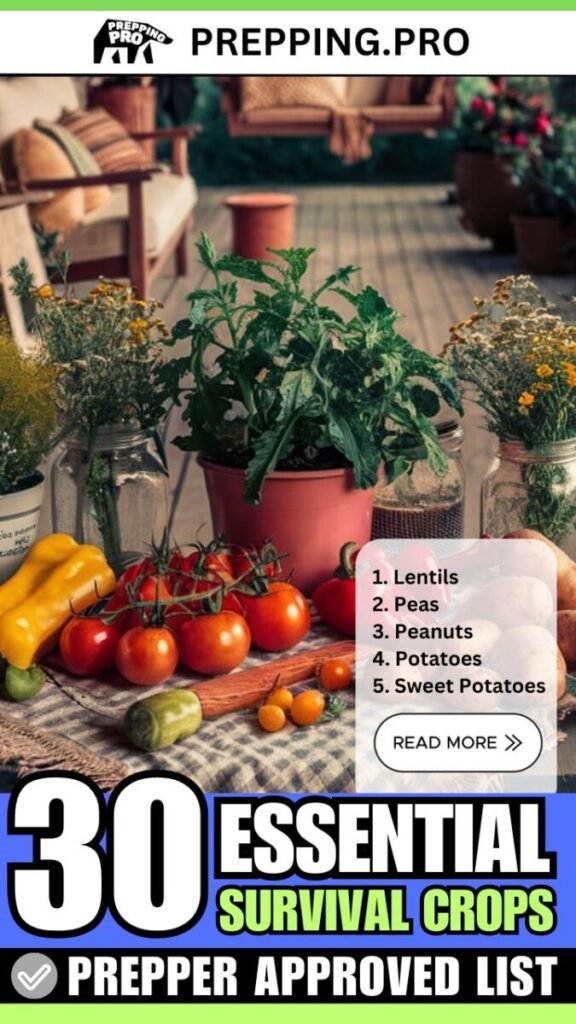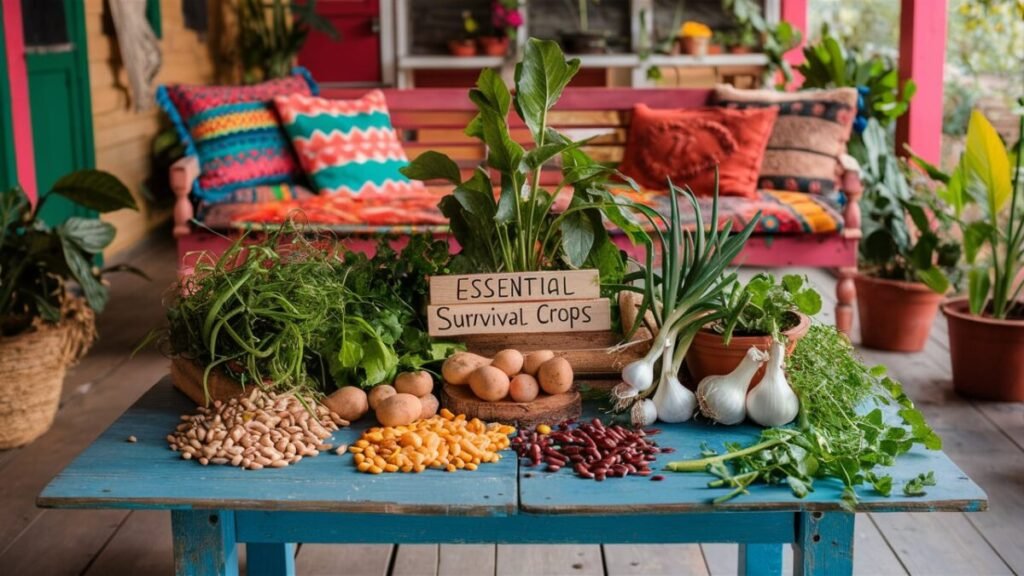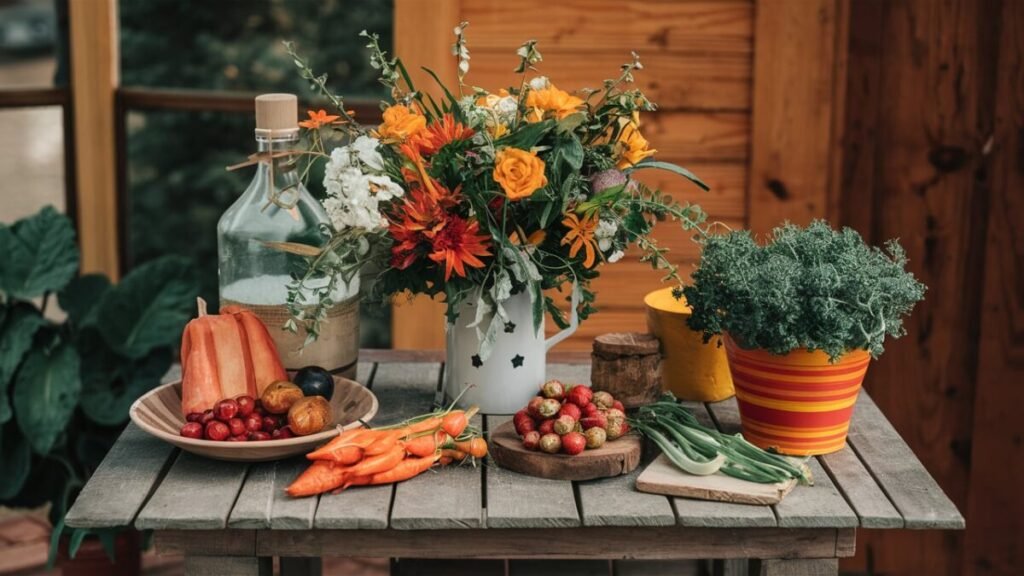Table of Contents
Introduction
Survival gardening is more than just a hobby—it’s a crucial skill for preppers and those seeking self-sufficiency.
In this comprehensive guide, we’ll explore the 30 essential survival crops that every prepper should consider growing.

These plants form the foundation of a resilient food production system, ensuring you have access to vital nutrients even in challenging times.
Learn how to start your survival garden and take the first step towards food independence.
Key Takeaways:
- Discover high-yield, nutrient-dense crops for maximum food security
- Learn about drought-tolerant and low-maintenance plants for challenging environments
- Explore storage crops that provide sustenance throughout the year
- Understand the principles of permaculture for sustainable gardening practices
1. The Fundamentals of Survival Gardening

Permaculture gardening principles underpin successful survival gardens. This approach creates a resilient agriculture system that mimics natural ecosystems. Preppers must balance nutrition, yield, and ease of cultivation to maximize their garden’s efficiency.
Key principles for survival gardening include:
- Utilize companion planting to improve soil health and deter pests
- Implement water conservation techniques like mulching and drip irrigation
- Practice crop rotation to maintain soil fertility and reduce disease pressure
- Save seeds from your best-performing plants for future growing seasons
Avoid common gardening mistakes to ensure your survival garden thrives.
| Principle | Benefit |
|---|---|
| Companion Planting | Improves soil health, deters pests |
| Water Conservation | Reduces water usage, improves plant resilience |
| Crop Rotation | Maintains soil fertility, reduces disease pressure |
| Seed Saving | Ensures future crop availability, adapts plants to local conditions |
2. Staple Grains and Pseudo-Grains
Grains and pseudo-grains provide essential carbohydrates and serve as nutritious food staples. These crops offer high calorie density and long-term storage potential. Consider growing amaranth as a versatile survival crop.
Wheat and Ancient Grains
Wheat varieties like einkorn and spelt offer excellent nutritional profiles and adaptability to various growing conditions. These grains form the basis for many staple foods.
Corn (Maize)
Corn serves as a versatile crop for both human and animal consumption. It grows quickly and produces high yields in favorable conditions.
Rice
Rice thrives in water-rich environments and provides a reliable source of carbohydrates. Preppers in suitable climates should prioritize this crop.
Quinoa and Amaranth
These pseudo-grains offer complete protein profiles and grow well in diverse climates. Their nutrient density makes them valuable additions to any survival garden.
| Crop | Calories per 100g | Protein per 100g | Storage Life (properly stored) |
|---|---|---|---|
| Wheat | 340 | 13g | 20-30 years |
| Corn | 365 | 9g | 10-15 years |
| Rice | 130 | 2.7g | 25-30 years |
| Quinoa | 368 | 14g | 2-3 years |
3. Nutrient-Dense Legumes
Legumes provide essential protein and fiber, making them crucial for a balanced survival diet. These crops also improve soil health through nitrogen fixation. Learn about high-calorie crops you can grow in containers.
Beans
Various bean types offer diverse nutritional profiles and cooking applications. Bush beans provide quick harvests, while pole beans offer extended production.
Lentils
Lentils grow quickly and require minimal water. Their high protein content and ease of storage make them an excellent survival crop.
Peas
Peas thrive in cooler weather and offer both fresh eating and dry storage options. They also serve as an excellent rotation crop.
Peanuts
Peanuts provide healthy fats and protein. These legumes grow well in warmer climates and store for extended periods when properly dried.
| Legume | Protein per 100g (dried) | Fiber per 100g (dried) | Days to Maturity |
|---|---|---|---|
| Beans (average) | 21g | 15g | 60-100 |
| Lentils | 25g | 31g | 80-110 |
| Peas | 23g | 25g | 60-70 |
| Peanuts | 26g | 9g | 120-150 |
4. Calorie-Dense Root Crops
Calorie-dense crops like root vegetables provide substantial energy and store well for long periods. These crops form a critical component of any survival garden. Discover why potatoes are an essential survival crop.
Potatoes
Potatoes offer high yields and excellent nutritional value. They grow in diverse climates and store well in cool, dark conditions.
Sweet Potatoes
Sweet potatoes provide vitamin A and grow well in warmer regions. Their leaves are also edible, offering additional nutrition.
Cassava (Manioc)
Cassava thrives in tropical and subtropical climates. This starchy root crop offers high calorie density and grows in poor soil conditions.
Turnips and Rutabagas
These hardy root vegetables grow quickly and tolerate cold weather. Both the roots and greens provide valuable nutrients.
| Root Crop | Calories per 100g | Storage Life | Growing Season |
|---|---|---|---|
| Potatoes | 77 | 2-5 months | Cool season |
| Sweet Potatoes | 86 | 3-5 months | Warm season |
| Cassava | 160 | 1-2 weeks (fresh), 1 year (dried) | Year-round (tropical) |
| Turnips | 28 | 4-5 months | Cool season |
5. Versatile and Nutritious Squash Family
Squash varieties offer versatility in cooking and excellent nutritional profiles. These plants often produce high yields and store well. Learn about fast-growing vegetables for quick harvests.
Pumpkins
Pumpkins provide vitamin A and healthy seeds. Their long storage life makes them valuable for winter nutrition.
Winter Squash Varieties
Varieties like butternut and acorn squash offer dense nutrition and long storage potential. They grow well in many climates.
Zucchini and Summer Squash
These fast-growing plants provide fresh vegetables throughout the growing season. Their high yield makes them valuable for short-term food production.
| Squash Type | Yield per Plant | Storage Life | Key Nutrients |
|---|---|---|---|
| Pumpkins | 2-5 fruits | 2-3 months | Vitamin A, Fiber |
| Winter Squash | 3-5 fruits | 3-6 months | Vitamin C, Potassium |
| Zucchini | 6-10 lbs | 1-2 weeks (fresh) | Vitamin B6, Manganese |
6. Leafy Greens for Vital Nutrients
Leafy greens provide essential vitamins and minerals. These crops often grow quickly and can be harvested multiple times. Explore options for indoor edible plants.
Kale and Collard Greens
These nutrient-dense greens tolerate cold weather and offer extended harvests. They provide crucial vitamins A, C, and K.
Spinach
Spinach grows quickly and offers high iron content. It thrives in cooler weather and can be succession planted for continuous harvests.
Swiss Chard
Swiss chard provides steady harvests throughout the growing season. Its tolerance for both heat and cold makes it a versatile crop.
Lettuce Varieties
Various lettuce types offer quick harvests and diverse textures. Loose-leaf varieties allow for continual harvesting.
| Leafy Green | Days to Maturity | Key Nutrients | Growing Season |
|---|---|---|---|
| Kale | 50-65 | Vitamins A, C, K | Cool season |
| Spinach | 30-45 | Iron, Folate | Cool season |
| Swiss Chard | 50-60 | Vitamins A, C, K | Year-round |
| Lettuce | 30-60 | Vitamin A, Folate | Cool season |
7. Fruit-Bearing Vegetables
Fruit-bearing vegetables provide essential vitamins and add variety to survival diets. These crops often produce abundantly in favorable conditions. Discover high-yield vegetables for maximum production.
Tomatoes
Tomatoes offer versatility in cooking and preservation. Determinate varieties provide concentrated harvests, while indeterminate types offer extended production.
Peppers
Both sweet and hot peppers provide vitamin C and flavor variety. These plants often produce abundantly in warm weather.
Eggplants
Eggplants thrive in warm climates and offer unique texture and flavor. They provide a good source of fiber and antioxidants.
| Vegetable | Days to Maturity | Yield per Plant | Key Nutrients |
|---|---|---|---|
| Tomatoes | 60-80 | 10-15 lbs | Vitamin C, Lycopene |
| Peppers | 60-90 | 2-5 lbs | Vitamin C, Vitamin A |
| Eggplants | 65-80 | 4-6 fruits | Fiber, Potassium |
8. Alliums for Flavor and Health
Alliums provide flavor and health benefits to survival diets. These plants often store well and offer medicinal properties. Learn about natural pest control methods.
Onions
Onions grow in various climates and store well for extended periods. They provide flavor and antioxidants to meals.
Garlic
Garlic offers both culinary and medicinal benefits. It stores well and can be grown in many climates.
Leeks
Leeks provide a milder onion flavor and grow well in cooler weather. They offer good nutrition and versatility in cooking.
| Allium | Days to Maturity | Storage Life | Key Benefits |
|---|---|---|---|
| Onions | 90-110 | 1-6 months | Antioxidants, Flavor |
| Garlic | 240-270 | 3-5 months | Antimicrobial, Flavor |
| Leeks | 120-150 | 1-3 months | Vitamin K, Manganese |
9. Drought-Tolerant Plants for Challenging Environments
Drought-tolerant plants ensure food production in challenging conditions. These crops often require minimal inputs and thrive in poor soil. Explore more drought-resistant plants for your garden.
Jerusalem Artichokes (Sunchokes)
Jerusalem artichokes grow with minimal care and provide edible tubers. They offer high yields and can become invasive if not managed.
Okra
Okra thrives in hot, dry conditions and provides both edible pods and leaves. It offers a good source of fiber and antioxidants.
Cowpeas
Cowpeas tolerate drought and poor soil conditions. They fix nitrogen in the soil and provide both edible pods and dried beans.
Millet
Millet grows quickly and requires minimal water. This grain crop offers good nutrition and grows well in areas unsuitable for other grains.
10. Long-Lasting Storage Crops
Long-lasting storage crops provide food security through winter months or extended crises. These plants offer good nutrition and maintain quality for extended periods. Learn about winter gardening techniques to extend your growing season.
Cabbage
Cabbage stores well in cool conditions and offers versatility in preparation. It provides vitamin C and fiber.
Carrots
Carrots offer excellent nutrition and store well in cool, moist conditions. They provide vitamin A and antioxidants.
Beets
Beets store well and offer both edible roots and greens. They provide essential minerals and antioxidants.
| Crop | Storage Life | Optimal Storage Conditions | Key Nutrients |
|---|---|---|---|
| Cabbage | 3-4 months | 32-40°F, 95% humidity | Vitamin C, Fiber |
| Carrots | 4-6 months | 32-38°F, 98% humidity | Vitamin A, Beta-carotene |
| Beets | 3-5 months | 32-40°F, 95% humidity | Folate, Manganese |
11. Low-Maintenance Perennial Crops
Low-maintenance crops provide reliable yields with minimal annual labor. These perennial plants often improve soil health and biodiversity in the garden. Discover perennial fruits and vegetables for your survival garden.
Asparagus
Asparagus provides early spring harvests and requires little maintenance once established. It offers a good source of vitamins and minerals.
Rhubarb
Rhubarb thrives in cooler climates and provides reliable spring harvests. Its tart stalks offer versatility in cooking and preserving.
Berry Bushes (Raspberries, Blackberries)
Berry bushes provide antioxidant-rich fruits and require minimal care once established. They offer extended harvests and can be preserved for long-term storage.
| Crop | Years to Full Production | Harvest Season | Key Benefits |
|---|---|---|---|
| Asparagus | 3-4 | Early Spring | Long-lived, Nutrient-dense |
| Rhubarb | 2-3 | Spring | Cold-hardy, Versatile use |
| Berry Bushes | 2-3 | Summer | High in antioxidants, Extended harvest |
Conclusion

Essential survival crops form the foundation of self-sufficient food production for preppers.
This diverse selection of 30 crops ensures a well-rounded diet rich in essential nutrients.
Preppers should focus on:
- Balancing calorie-dense staples with nutrient-rich vegetables
- Incorporating drought-tolerant and low-maintenance crops for resilience
- Utilizing storage crops to extend food availability
- Implementing permaculture principles for sustainable, long-term production
A well-planned survival garden provides food security and independence in uncertain times.
Start small, gradually expand your garden, and continually improve your skills to build a truly resilient agriculture system.
Learn about common plant diseases to protect your crops.
Key takeaways for successful survival gardening:
- Diversify your crop selection to ensure balanced nutrition
- Focus on crops well-suited to your local climate and conditions
- Implement water conservation techniques to maximize efficiency
- Learn proper storage and preservation methods to extend your harvest
- Continuously educate yourself on gardening techniques and crop management
By incorporating these essential survival crops into your prepping strategy, you’ll create a robust and sustainable food production system capable of supporting you through various challenges.
Remember, a thriving survival garden not only provides physical sustenance but also offers peace of mind and a sense of self-reliance in an unpredictable world.
Explore urban survival gardening techniques for those with limited space, and consider vertical gardening for preppers to maximize your growing area.
Don’t forget to create a survival seed bank to ensure long-term food security.


